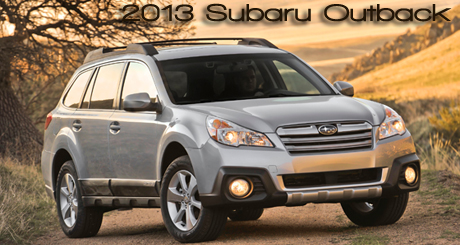
2013 Subaru Outback Road Test Review
By Bob Plunkett
We're buckled to the bucket of a juiced 2013 Outback 3.6R, Subaru's 5-door crossover wagon built in Indiana, with hands working a sporty steering wheel on a hair-raising drive test through the Blue Ridge Mountains of North Carolina.
The automatic transmission's manual shift mode runs through paddle shifters planted on the steering wheel, so we play the finger-flicker game to manage all of the torque from a gutsy boxer-6 engine and send it to all of the wheels through a 4-wheel-drive mechanism which operates automatically with Variable Torque Distribution (VTD).
Outback was designed to live up to its rugged name.
It has the rigid unibody structure of a car but a hiked suspension which compares in height to a sport utility vehicle. And it carries the all-wheel-drive (AWD) traction system that's always engaged. With all tires clawing for grip and the chassis elevated, an Outback can bump across a rocky field, scamper through a creek bed and zip down a rugged 2-rut trail to reach a backwoods campground.
And Outback scoots through snow like a snowmobile, which may explain why sales run high in Snow Belt states like Vermont, Colorado and Washington.
But the 2013 Subaru Outback also delivers the poise and easy-to-drive traits of a fine sedan -- it owns a curvy mountain road and mainlines on a freeway with a cushy ride quality, then provides a spacious passenger compartment stocked with comfy seats and cabin perks comparable to a luxury car.
When Subaru introduced Outback in 1996, it became the world's first crossover vehicle, although at the time no one knew what a crossover was -- one vehicle with pliable traits of a sporty car in a format that resembles either a high-hiked station wagon or a dropped-down SUV.
Subaru added refinements through four generations, beefing it up with a rugged body and larger tires, more sophisticated vehicle controls and powertrain options.
But Outback of 2013 elevates the concept with modern package styling, better utility and boosted performance thanks to a restyled prow, a more efficient base powertrain with an improved continuously variable transmission (CVT) plus revised suspension tuning.
The 2013 Outback also offers Subaru's optional EyeSight safety system, which employs two cameras pegged on the windshield to regulate the on-board adaptive cruise control system, warn the driver if the Outback drifts from of its intended traffic lane or even apply brakes automatically to avoid or minimize a collision.
Outback's platform reveals a wide track and a low center of gravity, with a ground clearance of 8.6 inches.
The suspension is fully independent with tuned MacPherson struts up front and a double wishbone in back designed to generate smooth-ride traits as well as consume less space so the rear cargo bay expands.
And the steering system, through a rack and pinion arrangement, is tuned for quick responses with a precise on-center feel from the wheel.
The 4-wheel disc brakes tie to an anti-lock brake system (ABS) with electronic brake distribution (EBD) and electronic brake assist (EBA) plus a stability system under Subaru's label of Vehicle Dynamics Control (VDC) with a 4-wheel traction control system (TCS).
Subaru segments Outback 2013 by two powertrains, and then lists trim tiers of Base, Premium and Limited.
Outback's new entry-level engine is a 2.5-liter 4-cylinder design with cylinders opposed horizontally and set perpendicular to the drive line.
The plant features dual overhead camshafts and four valves per cylinder with AVCS (active valve control system) for variable valve timing on intake and exhaust valves.
It generates 173 hp at 5600 rpm and torque of 174 lb-ft at 4100 rpm.
This engine works with a 6-speed manual transmission or Subaru's Lineartronic CVT with manual shift mode and paddle shifters at hand on the steering wheel.
Top editions Outback 3.6R and 3.6R Limited tote Subaru's horizontally-opposed 6-cylinder engine which displaces 3.6 liters and also features AVCS.
The 3.6-liter engine delivers a robust 256 hp at 6000 rpm plus torque of 247 lb-ft at 4400 rpm, and it ties to Subaru's electronically controlled 5-speed automatic with steering wheel paddle shifters.
All editions of Outback 2013 employ AWD equipment, although the device differs by transmission type.
With a manual six-speed shifter, the continuous AWD system has a viscous-coupling locking center differential (VCLCD) designed to distribute the engine's power evenly between front and rear wheels. Slippage of front or back wheels may prompt the device to redirect some of the power to the wheels not slipping, and it's possible to send all of the torque to the front or rear.
With the CVT, the active AWD system has a continuously variable hydraulic transfer clutch (CVHTC) managed electronically, while for the electronic automatic transmission Subaru adds variable torque distribution (VTD) to the AWD system with a planetary center differential and an electronically controlled CVHTC to distribute the power, which normally split 45/55 percent front/rear but can modify that ratio if tires slip.
MSRP figures for the new and improved Outback of 2013 range from $23,495 to $32,095.
For more information on Subaru vehicles, click here.
|